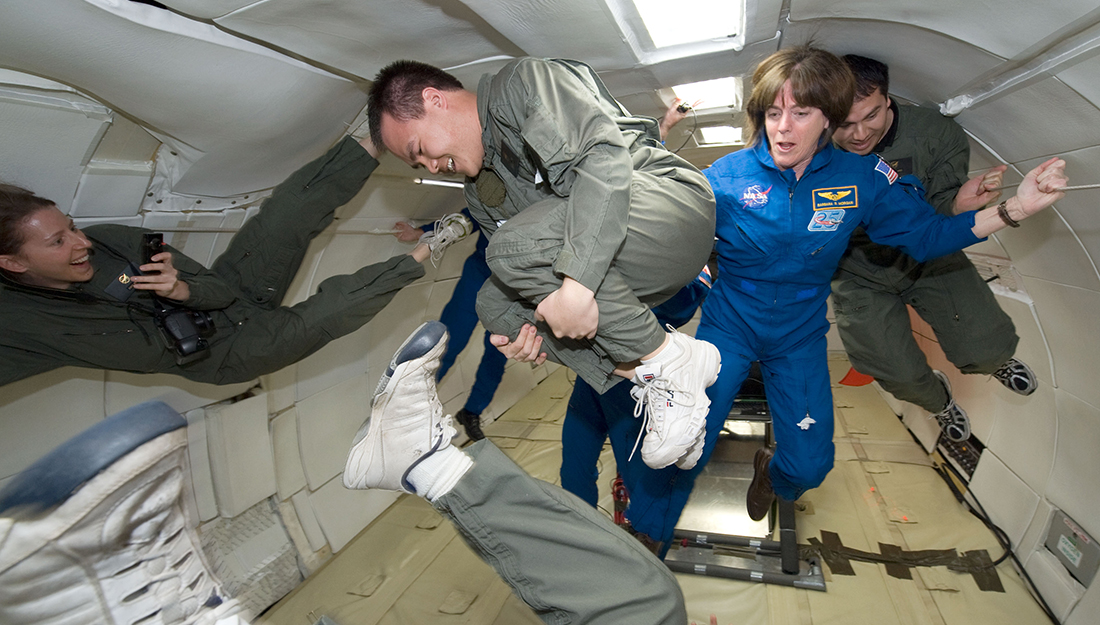- Christina Sumners
- Medicine, Research, Show on VR homepage
Solving the medical mysteries of space flight
Microgravity and radiation take their toll physiologically, but how?

PHOTO DATE: 03/30/09
LOCATION: ELLINGTON
SUBJECT: STUDENT CAMPAIGN ZERO G FLIGHT
PHOTOG: GEESEMAN
When male astronauts spend weeks or months in space, a strange thing happens to their eyesight: They go from having the perfect vision required to make it into the space program to having, at best, a mild vision impairment. For male astronauts (so far, only men have been shown to be affected) wanting to make the trek to Mars one day, this would be disastrous, since the mission will take a few years—just imagine arriving on Mars and not being able to see well enough to land.
“We think that’s why NASA is so interested in our work,” said David Zawieja, PhD, Regents Professor at the Texas A&M College of Medicine. He’s the lead investigator for the lymphatics portion of a recent space flight experiment examining the effect of microgravity on eyesight that sent 20 animal models into space to live on the International Space Station for about a month as part of NASA’s Vision Impairment and Intracranial Pressure program.
“We believe that increases in pressure, which propagate down the cranial nerve to the eye, may help explain the vision changes we’re seeing in astronauts,” Zawieja said. The team looked for vascular changes that may affect pressure of cerebral spinal fluid, the clear liquid found in the brain and spinal cord, and factors involved in its regulation. However, this was only one part of the multi-institution, multi-team project.
A second team from Texas A&M examined coronary artery function. “We were the first researchers ever to study isolated coronary vessels following spaceflight,” said Pooneh Bagher, PhD, assistant professor at the College of Medicine and the lead investigator on this part of the project. “The heart is a unique organ, and if you have some coronary artery dysfunction, you could have heart dysfunction which would affect the entire body.”
Zawieja and his colleagues worked with NASA before to study the effect of the space environment on cerebral blood and lymph vascular functions, but these were done using mostly simulated microgravity, not actual space flight.
Now, in collaboration with principal investigator and longtime collaborator Michael Delp, PhD, formerly at Texas A&M and now at Florida State University, the team studied the effects of actual space flight on these 20 animal models that were launched from the Kennedy Space Center in early August. After the models landed in the Pacific Ocean in September, all of the research teams went to Loma Linda University in California to conduct experiments immediately upon landing. “It’s important that the animals have as little exposure to earth gravity as possible, which is why we went to California to conduct the research,” Zawieja said.
Next, the entire team will pack up and move to Kennedy Space Center to compare the results of the animals in space with two control groups on the ground.
Although the effects of space flight on the body is an exceptional situation, the team says that it has potential to help them understand the human body in new ways and master techniques that can help them in future studies, whether related to space travel or not. “We are looking at how a very unique thing affects physiology,” Bagher said. “Working in this environment has changed the way we think about science.”
Working on NASA-sponsored projects has been an amazing experience for Zawieja as well. “I’ve really been a space geek since I was a little kid,” he said. “What’s really fun about NASA work is the teamwork aspect. We have the opportunity to work with a wonderful team of colleagues from many institutions to solve a problem that NASA has, one that will affect the entire future of space exploration.”
Media contact: media@tamu.edu


